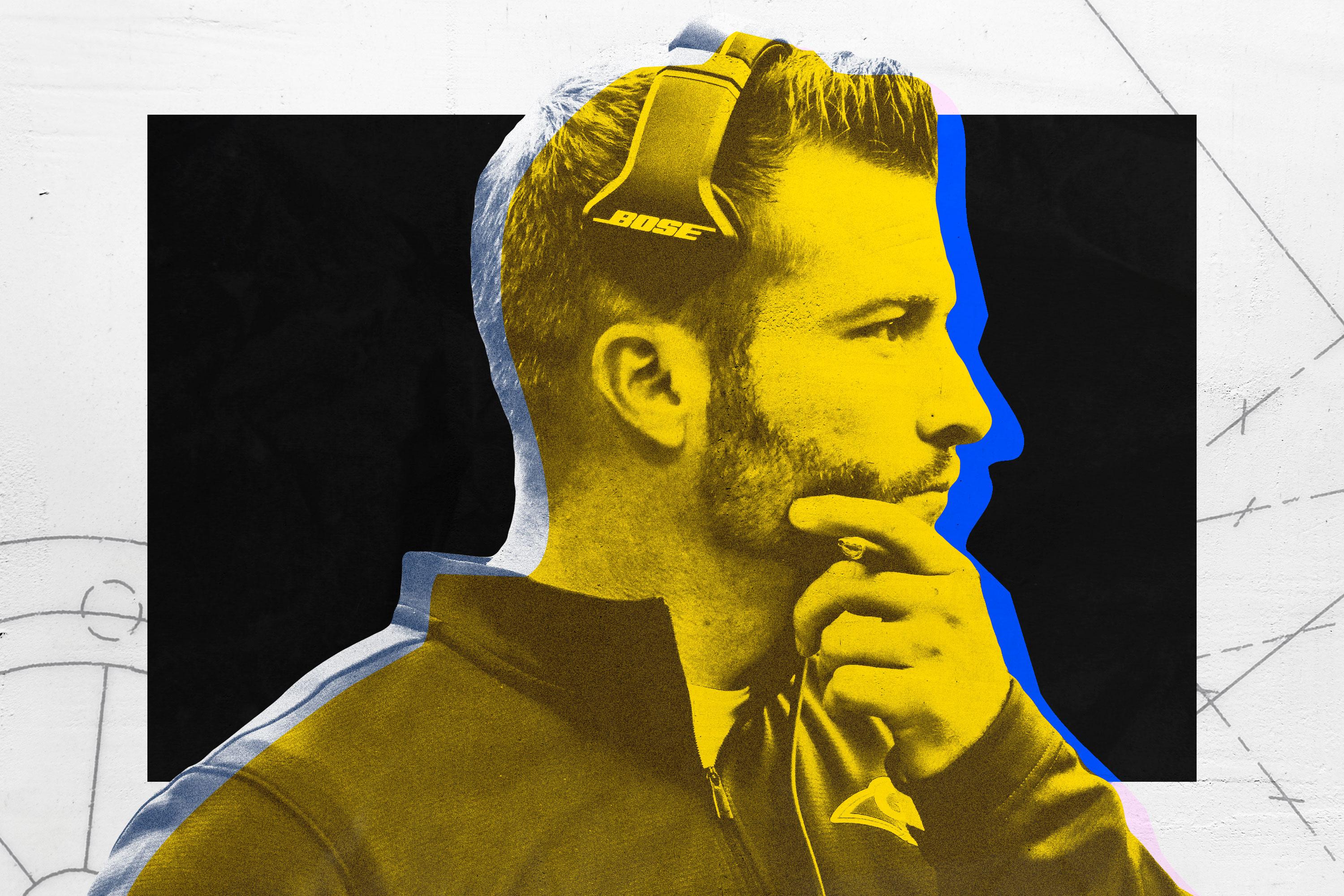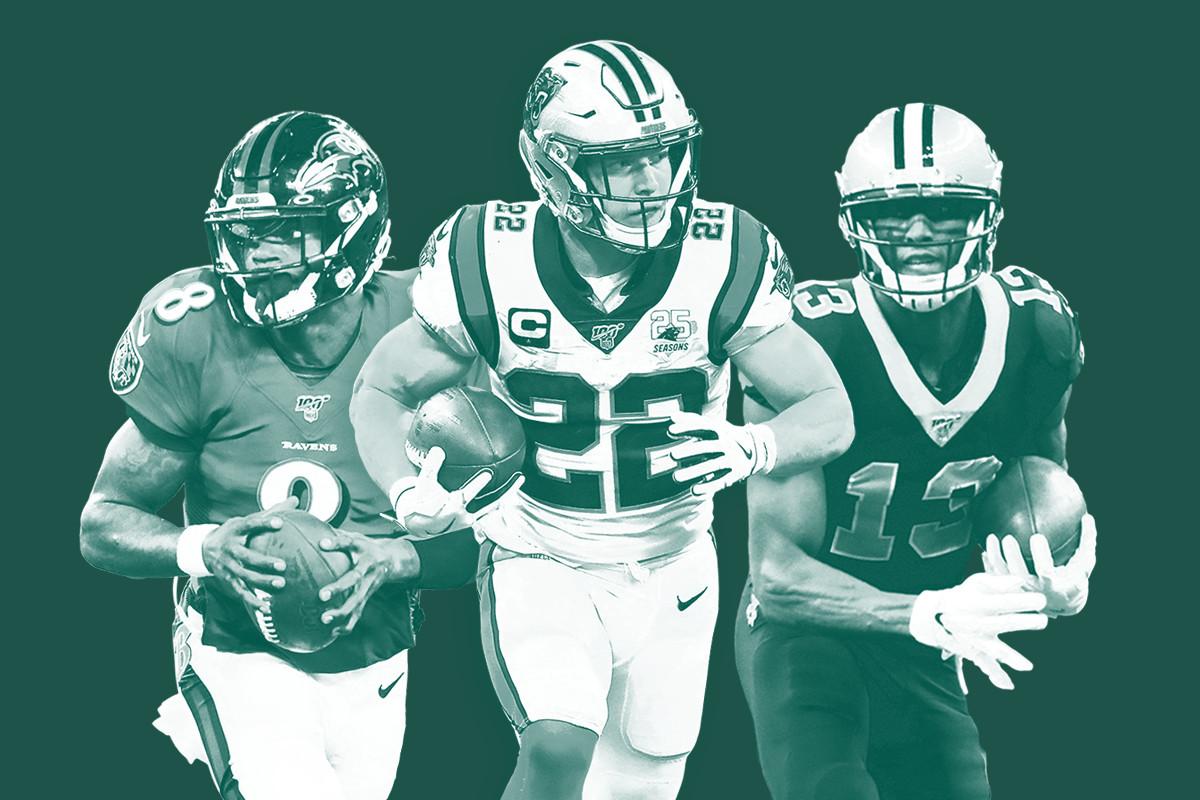Sean McVay Is Going to Have to Learn How to Do More With Less
Two seasons ago, McVay was the most-hyped coach in the NFL. But after an up-and-down 2019, the shine has worn off. A roster and coaching staff overhaul suggests it may take more ingenuity for him to help the Rams reach those same heights.
Remember when we all thought the Browns were the NFL’s next dominant team? Or that Carson Wentz was a no-brainer future MVP? Or that Sean McVay was the league’s next great mastermind? Some of the NFL’s teams, players, and coaches who were in the spotlight the past few seasons enter 2020 with tempered expectations—but that doesn’t mean we should count them out. Welcome to The Ringer’s Post-Hype Week, when we revisit some of the league’s biggest story lines from seasons past that aren’t getting as much love ahead of this campaign.
Sean McVay came to Los Angeles preaching a culture of “We not me.” The phrase is written on Rams playbooks and on locker room signs. “That culture of ‘we’ that you’ll hear us consistently talk about is what’s going to allow us to achieve goals,” the head coach said at his introductory press conference in 2017. The irony is that McVay has become a star bright enough to outshine the team. He has been called a genius, a prodigy, the man at the forefront of football’s future. But entering the 2020 season, the Rams are one of the least-hyped teams for this year despite appearing in a Super Bowl two seasons ago with one of the most-hyped coaches in recent memory.
The Rams hired McVay when he was 30, making him the youngest head coach in NFL history. He inherited a team whose last winning record was in 2003—when McVay was a senior in high school—and brought them to the Super Bowl in two years despite being four years younger than his left tackle, Andrew Whitworth. But McVay’s Rams weren’t just successful. They also represented the future of the sport. In the middle of the 2018 season, the Rams defeated the Chiefs 54-51 in one of the highest-scoring games in NFL history. The teams combined for 1,001 total yards, 827 passing yards, 14 touchdowns, and four lead changes in the fourth quarter. The contest was seen as a preview of where the NFL was going, with lightning-quick scoring that would rule the league for years to come. L.A.’s march to the Super Bowl in 2018-19 only solidified that sense. Sure, a historically awful pass interference call helped them get to the Super Bowl, and McVay’s offense was flattened by the Patriots, as the Rams scored just three points once they got there. But that didn’t stop the McVay hype. If his squad had made the Super Bowl when he was 32, how long could the Rams’ title window last? Other teams wanted to tap into the Rams’ success.
What those teams wanted was an offensive genius who could use fresh ideas to make their team into a Super Bowl contender. But what happened was those teams hired a bunch of handsome white men with thin résumés who knew Sean McVay. His 39-year-old offensive coordinator, Matt LaFleur, was hired to coach the Packers. His 35-year-old quarterbacks coach, Zac Taylor, was hired to run the Bengals. When the Cardinals hired USC offensive coordinator Kliff Kingsbury as their coach, they noted in the press release that “Kingsbury is friends with Rams coach Sean McVay—the 32-year-old offensive genius who has become the blueprint of many of the new coaching hires around the NFL.”
Less than two years after everyone wanted their own Sean McVay, the real Sean McVay is rarely described as a genius anymore. Criticism of him is rare, but the glowing praise has dulled. The Rams missed the playoffs in 2019, becoming one of just two Super Bowl losers to miss the playoffs the following season in the past 10 years. Entering 2020, they’re tied with Kingsbury’s Cardinals for the lowest odds (6-1) to win the NFC West. McVay—who is still the youngest head coach in the NFL—was an unprecedented hire who almost delivered a Super Bowl within two years. But to get back, McVay is going to have to do more with less.
Today, the Rams are hamstrung by their own ambition. No NFL team has taken the concept of going all in on a season—sacrificing future assets for the chance at a championship now—as seriously as the Rams. They traded draft picks and sacrificed cap space to build a contender, and McVay nearly delivered. Now they’re dealing with a hangover that could last years, and McVay is the one who’ll have to figure out a culture of we even when the “we” has changed.
Half of the Rams’ 22 starters from their Super Bowl appearance are no longer with the team. Seven of those 11 players were on defense; starting defensive tackle Ndamukong Suh, cornerbacks Marcus Peters and Aqib Talib, safety Lamarcus Joyner, and linebackers Cory Littleton, Mark Barron, and Dante Fowler all were traded, cut, or left in free agency over the past two years. Entering the 2020 season, as the COVID-19 pandemic has limited practice time, continuity figures to be essential. But the Rams rank second-to-last in defensive snaps retained from the 2019 season. McVay also parted ways with coordinator Wade Phillips, whose defense held the Patriots to just 13 points in Super Bowl LIII. But the most notable players the Rams lost were on offense. 2018 Offensive Player of the Year Todd Gurley was cut this offseason just two years after signing a four-year contract guaranteed for $45 million. The running back was the face of the team and the center of the Rams offense in 2017 and 2018, but has not been the same player since aggravating a knee injury in December 2018. Center John Sullivan retired after the Super Bowl and guard Rodger Saffold left for Tennessee. Earlier this year, receiver Brandin Cooks was traded to the Houston Texans in exchange for a second-rounder the team used on Ole Miss receiver Van Jefferson.
Replacing players is not usually an issue for strong organizations, but the Rams have not had a first-round pick since 2016 and are not scheduled for another one until 2022 (no, the Rams have not used a first-rounder since McVay came aboard). The last first-rounder the Rams used was in 2016, when they traded with the Titans to take Jared Goff no. 1. But that cost them their first-rounder in 2017. The team dealt its first-rounder in 2018 to New England for Cooks, traded out of the first round in 2019, and then sent their first-rounders in 2020 and 2021 to Jacksonville for cornerback Jalen Ramsey last year (a bewildering move considering they traded Marcus Peters, a former All-Pro cornerback whom they acquired in 2018, to Baltimore for just a fifth-rounder). Assuming the Rams don’t trade into the first round next year, they will be just the fourth team in the past 50 years to go five consecutive years without a first-round pick (the record for a first-round drought is Washington, who did not use a first-rounder for the entire 1970s).
Any team that doesn’t make first-round picks for several years is going to decline, but the Rams also made financial decisions that clogged their cap. The salary cap has not been a huge obstacle in recent years because it has gone up by more than $100 million since 2005. “I can distinctly remember the days when it was almost every year, you had to let people go because of money,” Rams general manager Les Snead told The Ringer’s Kevin Clark in January 2018. “Nowadays, I don’t ever remember thinking, ‘Uh-oh, we’re up against the books here.’ Now, it’s more of a strategy. ‘If we keep this guy, what does it keep us from doing?’ It’s not, ‘Hey, we’ve gotta do some things just to get legal.’ I think that’s what has allowed you to make, let’s call it ‘strategic football decisions.’”
The Rams are up against the books now. When Snead said that, the Rams had two of the NFL’s best players (Gurley and Aaron Donald) on cheap contracts, not to mention a quality quarterback on a rookie deal, the best bargain a team can ask for in the NFL. But as those players matured, the Rams paid them hefty deals, beginning in 2018. Donald is just one of three players along with J.J. Watt and Lawrence Taylor to win Defensive Player of the Year in back-to-back seasons. Signing him to a record-setting contract extension was a no-brainer. Gurley, the Offensive Player of the Year and a team captain, was a less obvious case considering the decline of running back value—only punters and kickers are paid less—and Gurley’s knee issues dating back to college. But the Rams also gave a sizable extension to Cooks, whom the team had traded a first-rounder to the Patriots to acquire. The following year, the Rams gave Goff a deal paying him an average of $33.5 million annually, the same as Aaron Rodgers. Suddenly a team that never had to worry about being low on cap space is now low on cap space. The Rams traded Cooks to the Texans and cut Gurley this offseason; those players will cost the team more than $30 million in dead money. The Rams are using more than 40 percent of their $203 million budget this year on just four players—Goff, Donald, Gurley, and Cooks—and two of those guys aren’t on the team. Plus, soon they’ll have to re-sign Ramsey, who is in the last year of his contract and figures to become the highest-paid cornerback in the league.
So the Rams don’t have any good picks in the draft and don’t have any money to spend in free agency. Unsurprisingly, they filled their roster the past few years with middling draft picks and cheap veterans. At pass rusher they’ve tried to revive the careers of past stars (Clay Matthews) or jump-start the careers of former first-rounders who have not lived up to their potential (Dante Fowler Jr. and Leonard Floyd). The results have been underwhelming. Offensive line was a strength for the Rams in 2017 and 2018, but it became the team’s Achilles’ heel in 2019 after Sullivan retired and Saffold left. Last year, offensive linemen Brian Allen, Joseph Noteboom, and Rob Havenstein all missed significant time with injuries, leaving a lot of work for unproven rookies David Edwards and Bobby Evans (Allen, Noteboom, Edwards, and Evans were all drafted between the third and the fifth round in 2018 or 2019). The results were night and day: To understand how the Rams went from the Super Bowl to missing the playoffs, check out their drop-off in Pro Football Focus grading:
2018: no. 7 in pass blocking, no. 1 in run blocking
2019: no. 29 in pass blocking, no. 26 in run blocking
Without blocking, the Rams offense unraveled. The running game evaporated, dropping from almost 5.0 yards per carry in 2018 to 3.7 yards per carry in 2019. Their play-action passes became less effective. In 2018, Goff’s yards per pass on play-action attempts was 10.0, which ranked second among all QBs with at least 100 play-action attempts. In 2019, that dropped to 8.4, which wasn’t even in the top 10. Overall, the Rams went from second in yards per play (6.4) to 12th (5.7). Rock bottom came on Monday Night Football in Week 12, when the Ravens rocked the Rams 45-6 as Baltimore scored touchdowns on its first six possessions and held the Rams to two field goals while picking off two passes and forcing four three-and-outs. The Rams offensive line showed far more cohesion in the second half, but it wasn’t enough to make the playoffs. L.A. was eliminated in Week 16 by San Francisco, who replaced the Rams as NFC West champions, NFC champions, and reigning Super Bowl loser. The 49ers are the favorites to win the division again in 2020, but the Seahawks also look formidable after trading for Jets safety Jamal Adams, and the Cardinals got better by trading for Texans receiver DeAndre Hopkins. Meanwhile, the Rams seem likely to trot out a team with little improvement from last year.
The defense was the strength of the team in 2019, but McVay let coordinator Wade Phillips’s contract expire this offseason. Phillips was coaching NFL teams before McVay was born, and he was a key to the Rams’ defensive success (they held the Belichick-Brady Patriots to the fewest points they’ve ever scored in a Super Bowl). Phillips was also an important consigliere for a young coach like McVay learning to handle a team, but now Phillips and another experienced coach, special teams coordinator John Fassel, are gone. New defensive coordinator Brandon Staley is in his first year in that role. Between the departing defenders, new coordinators, and the limitations the pandemic has put on training camps, the L.A. defense that ranked ninth in defensive efficiency figures to decline.
The Rams will need their offense to be a lot better to compete for the division this year. With Cooks in Houston, the Rams may use two tight ends more often (with Gerald Everett and Tyler Higbee) after almost religiously using three receivers and one tight end in McVay’s first two years. Gurley is gone. He’s replaced by a committee of Florida State running back Cam Akers (a second-rounder in 2020), Memphis running back Darrell Henderson (a third-rounder in 2019), and unremarkable veteran back Malcolm Brown. Akers has speed and is used to working behind a patchwork line, but it’s unclear whether he can take on anywhere near the level of responsibilities Gurley had when the Rams were humming two years ago. The Rams have compared Henderson to both Alvin Kamara and Lance Dunbar, which are the most and least exciting comparisons a running back can get. If the offensive line can block better, having a cast of Akers, Everett, Higbee, and receivers Cooper Kupp and Robert Woods might be pretty effective. Kupp was third in receiving yards in the first half of the season, and Higbee led all players in receiving yards in December. But it will depend on Rams’ blocking. The Rams offensive line did improve as the season went on, and it will surely be better in 2020 without the midseason scramble to replace their starters. The unit is not likely to be elite, especially with right tackle Rob Havenstein looking like the league’s most overpaid player and left tackle Andrew Whitworth turning 39 in December, but the interior of the line can’t be worse than it was in the first half of 2019.
We will see what McVay does with this team. When he took over and said “We not me,” the Rams had a plethora of talented, cheap players in their prime. But the “we” has changed. The Rams have no picks and no money, and that is unlikely to change anytime soon. Since then, the Rams have lost half of their guys and gambled away their picks and pennies to replace them. The Rams weren’t wrong or reckless doing so—they got to the Super Bowl, and most teams would make that bet if they knew that would be the payoff. We saw what McVay can do when his team was loaded: He did more with more. But he might have to do more with less for the foreseeable future.


